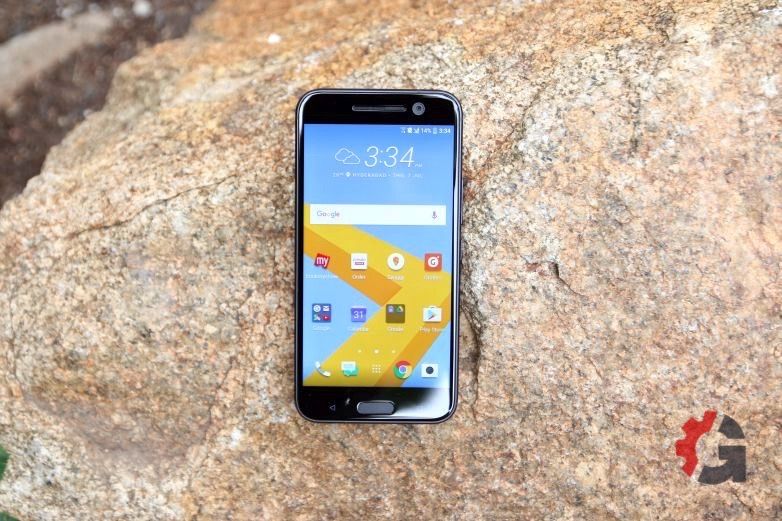
Back in 2014, HTC came pretty close to making the perfect flagship Android smartphone with the One M8. The device had got almost everything right (from impeccable design to fast software to booming audio) except for the imaging experience. HTC’s UltraPixel camera offered great performance in low-light conditions, but its low megapixel count (a measly 4 megapixels) meant the camera couldn’t live up to the standards set in place by other top-of-the-line smartphones.
HTC 10
What Is Good?
- Understated, premium design
- Fast performance
- Audio quality better than the competition
- HTC's best cameras yet
- Clean, modern software
What Is Bad?
- Battery life is mostly average
- Unsurprisingly slippery design
- BoomSound speakers not what they used to be
- Camera isn't as quick as other devices, blows out lights
Everyone expected HTC to make things right with the One M9, but the company took even more missteps. The UltraPixel camera remained unchanged, and HTC was also let down by Qualcomm’s Snapdragon 810 chipset, which was prone to overheating and had numerous performance issues as a result. HTC also decided that India didn’t need the One M9 and launched a few underpowered variants in the country instead. Needless to say, the Taiwanese manufacturer fell further behind its competition.
HTC’s latest attempt to achieve the perfection that has eluded it in the last couple of years has culminated in the HTC 10. It’s got the specs to match competing flagships like the Galaxy S7 and the LG G5, but doesn’t come with questionable features like an Edge screen or LG’s ‘Friends’ modules. Still, on paper, the 10 looks like the device HTC needs to make its comeback in the premium segment of the market. But is the real-world experience as good as it should be here in 2016? Let’s find out in this review.
HTC 10 Design: Premium design that looks great, feels great

Wow! Ooh! Nice! These are some of the words folks here at Gear by MySmartPrice used when they first picked up the HTC 10. Great design has always been HTC’s strong suit, and the company has continued the tradition with the 10. Well, at first glance it is pretty easy to confuse the phone with the Galaxy S7 edge, but pick up the 10 and you will realize how different it is. As usual, HTC has opted for a metallic build, and everything is put together extremely well.
Great design has always been HTC’s strong suit, and the company has continued the tradition with the 10.
The edges are chamfered and are smooth to the touch, and so is the metallic back. As with the Galaxy S7, the HTC 10’s back is curved at the sides to offer better grip. These curves tend to shine when they catch the light at certain angles – I personally thought this looked cool, although some might consider it a tacky part of what is otherwise a beautiful smartphone. Some might also dislike the fact that the front is bereft of the HTC logo – while the all-black front on our ‘Carbon Gray’ review unit makes for a clean look, it also makes for a look that lacks personality. Of course, the phone is also rather slippery, but that is a necessary sacrifice for making the phone feel as premium as it does.

The 10 is the first HTC flagship to feature a hardware home button at the front (it first made an appearance on the One M9 Plus, a less powerful variant of the One M9). Unlike on Samsung devices, this button works on touch and can’t actually be pressed. It doubles up as the fingerprint sensor and is accompanied by capacitive back and multitasking keys on the right and left. Unfortunately, these keys are placed too close to the bottom edge of the phone, so reaching for them can put some strain on your finger during one-hand usage.
HTC 10 Display: As good as an LCD display can get
The 10’s 5.2-inch Quad HD Super LCD5 display is as good as LCD displays get. Colours are sufficiently punchy, and you can opt for more accuracy by switching to the sRGB display mode. HTC also lets you set the display tone to your liking, although the display remains noticeably cool even at the warmest setting when compared to the displays on other phones. Viewing angles are pretty much perfect, and the only area where the screen really falters is in its brightness levels.
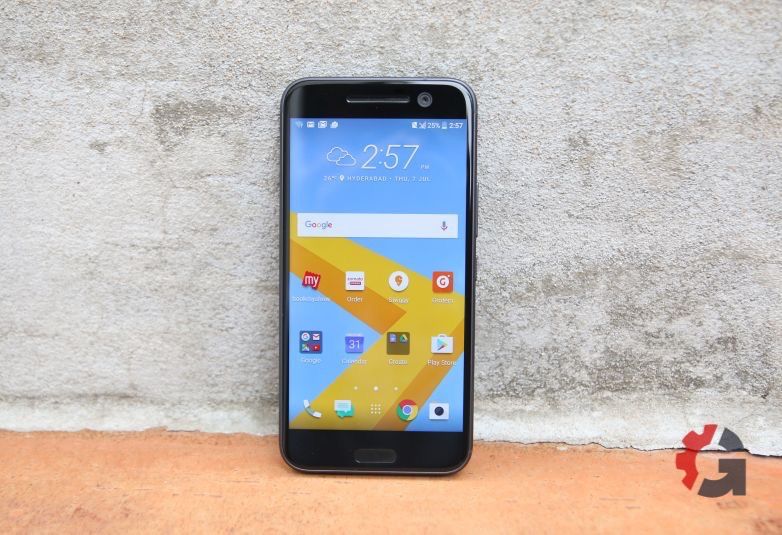
Indoors, the display was bright enough to make my eyes hurt, but out in the sun the screen’s high reflectivity made on-screen content slightly illegible at times. It doesn’t help that auto brightness does not compensate for the increased light if you happen to set the brightness to the lowest level, adding a few additional seconds wherein you have to blindly look for the brightness slider in the notification shade.
The 10’s 5.2-inch Quad HD Super LCD5 display is as good as LCD displays get.
A smooth touch experience is something every smartphone offers these days, but HTC might have gone a little overboard with the 10. At times, while trying to long press something, my finger would slide slightly and turn the input into a swipe instead of a press, prompting me to lift my finger off the screen and try again. This can be especially annoying when you’re trying to highlight text in an app or rearranging items on the home screen. HTC markets this annoyance as “the ultimate touch”, but I’m not sure if screen responsiveness of this level is actually needed on a smartphone.
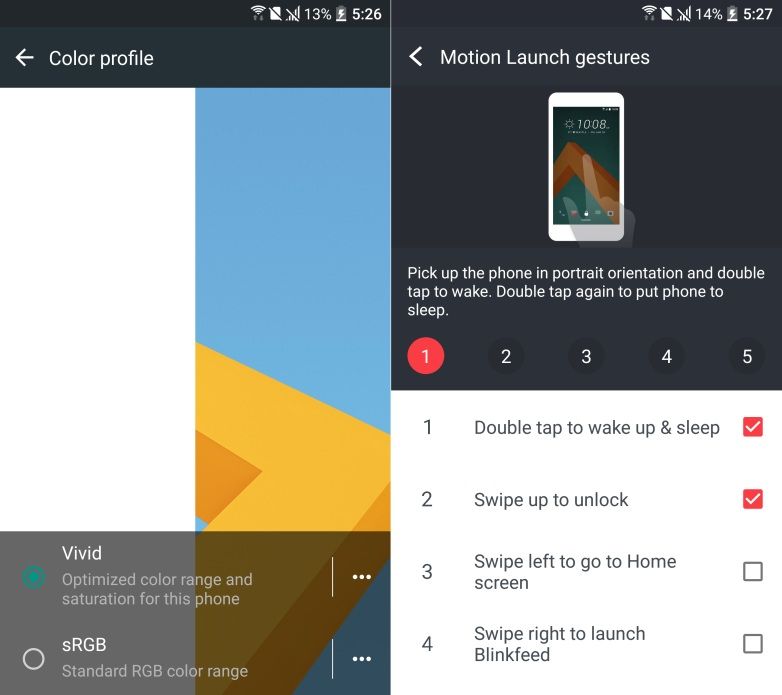
HTC 10 Camera: Excellent cameras are let down by their tendency to blow out light sources
Imaging is where HTC has goofed up the most ever since the One M7 came out with the low-resolution UltraPixel camera on-board. With the 10, HTC has retained the UltraPixel sensors but has increased the megapixel count from 4 to 12 megapixels, similar to competing devices like the Galaxy S7 or the latest iPhones. Well, the 10’s camera isn’t the best out there, but it is certainly the best seen on an HTC smartphone.
 The rear camera takes great shots that have high detail and accurate colours, both indoors and outdoors. Again, it’s not the best camera, but it comes pretty close to being it. Its tendency to blow out light sources at night because of the large pixel size (1.55 micron) of the UltraPixel sensor is what holds it back from being better than the competition. The large pixel size does enable you to take good photos in dimly lit conditions though, with the laser autofocus and optical image stabilization (OIS) helping out while taking shots of close-up objects. The 10 supports 4K video recording like pretty much every other flagship, and video quality was pretty good at even 1080p resolution.
The rear camera takes great shots that have high detail and accurate colours, both indoors and outdoors. Again, it’s not the best camera, but it comes pretty close to being it. Its tendency to blow out light sources at night because of the large pixel size (1.55 micron) of the UltraPixel sensor is what holds it back from being better than the competition. The large pixel size does enable you to take good photos in dimly lit conditions though, with the laser autofocus and optical image stabilization (OIS) helping out while taking shots of close-up objects. The 10 supports 4K video recording like pretty much every other flagship, and video quality was pretty good at even 1080p resolution.
The 10’s camera isn’t the best out there, but it is certainly the best seen on an HTC smartphone.
An UltraPixel camera is also present on the front, and the 10 is the first device to feature OIS on the user-facing camera. The front camera ekes out a lot of detail in selfies, which can sometimes work against you as you see your face’s imperfections rather clearly. Since it’s an UltraPixel camera, selfies in low light come out great. Naturally, you get the option to apply beauty filters when using the front camera; the front camera also has Autofocus, making it one of the best seen on any smartphone in the market.
 While HTC has done away with a lot of its proprietary apps on the 10, the camera app is still its own. It’s very simple, with just the shutter, video and photo buttons, and the flash and HDR toggles on-screen when you fire up the camera. Since the phone shoots at a 4:3 aspect ratio by default, none of these options fight for space with the viewfinder. You can access the camera settings and the different shooting modes by swiping in from the left of the display. A Pro mode is included for those of you who like to play around with camera parameters and get the most out of the scene they’re trying to capture.
While HTC has done away with a lot of its proprietary apps on the 10, the camera app is still its own. It’s very simple, with just the shutter, video and photo buttons, and the flash and HDR toggles on-screen when you fire up the camera. Since the phone shoots at a 4:3 aspect ratio by default, none of these options fight for space with the viewfinder. You can access the camera settings and the different shooting modes by swiping in from the left of the display. A Pro mode is included for those of you who like to play around with camera parameters and get the most out of the scene they’re trying to capture.
The camera’s shot-to-shot time is a bit long as the app takes a couple of seconds to focus and save a captured photo. Also, while there is support for voice control inside the camera, the 10 wasn’t very accurate at detecting my voice. This is in stark contrast to the Galaxy S7 – Samsung’s implementation of camera voice control is miles ahead, with the S7 picking up the image capturing hotwords even in noisy environments.
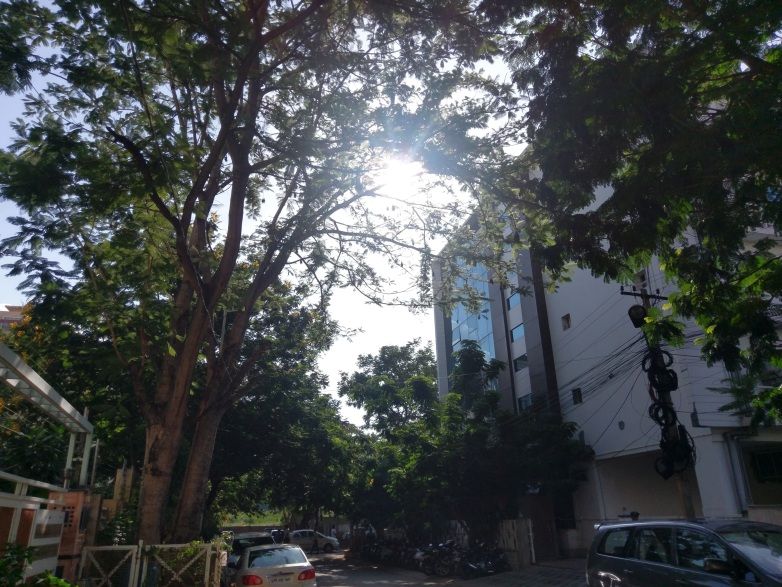
HTC 10 Audio: HTC BoomSound loses some of the “boom”
For the last few years, HTC’s flagships have offered excellent audio quality. Its front-facing BoomSound speakers used dedicated amplifiers for theater-like wire-free audio, and the company also used high-quality DACs to power impressive sound through headphones. While the latter remains true in the case of the 10, HTC’s BoomSound speakers have lost some of their boom in their latest iteration.
HTC’s BoomSound speakers have lost some of their boom in their latest iteration.
Instead of two full-fledged speakers on the front, HTC has opted to shift one speaker to the bottom of the phone (similar to the One A9). Right off the bat, you don’t get the stereo effect of the original implementation of BoomSound speakers. Furthermore, sound through the earpiece – which acts as one of the loudspeakers – isn’t as great as that from the bottom-facing speaker, which means that the overall quality suffers as well. The bottom speaker is actually quite bombastic, but you won’t hear the boom unless you put the speaker right next to your ear.
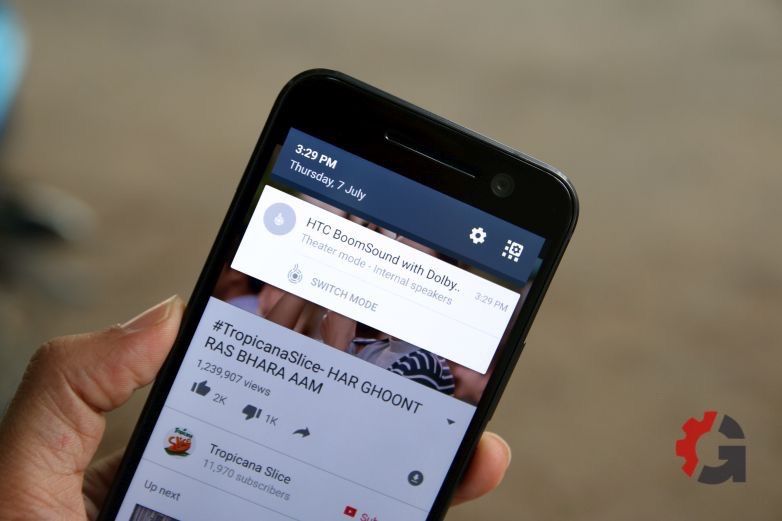
However, even with the bad placement, the audio experience on the 10 is of better quality than on any other flagship around. It’s not as loud as, say, the Galaxy S7 or the LG G5 despite these devices featuring a single speaker, but you can tell how the amplifiers behind each speaker make for clean, almost distortion-free output. You can switch between theater and music mode from the status bar. As the name suggests, theater mode makes for better surround sound, while music mode puts the focus on the vocals.
Call quality on the 10 was slightly better than average. The earpiece doesn’t get very loud, but I never had any trouble understanding what the other party was saying as long as I was in a relatively quiet area. Again, call quality fares slightly better than average, but it’s nothing to write home about in a 2016 flagship.
HTC 10 Software: Clean, modern UI
The HTC 10 runs Android 6.0.1 Marshmallow with HTC’s Sense UI on top. This year, HTC has pared down the modifications it makes to vanilla Android. Visually, the 10’s software is pretty much as customised as on earlier HTC phones, but the company has decided not to duplicate any of the functionality that stock Android already offers. Thus, the phone comes with Google apps such as Photos, Chrome, Calendar and Play Music instead of HTC’s proprietary offerings.
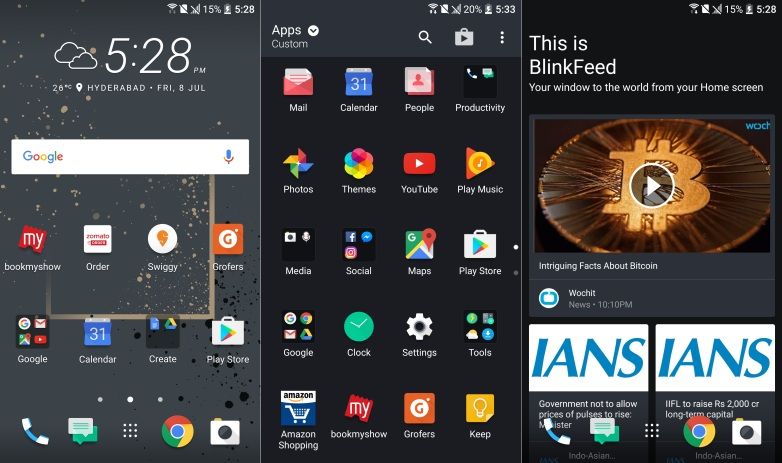
While this makes for a clean user experience, I found it to be a disadvantage at times, as some of Google’s own apps aren’t as great as HTC’s. Photos, for example, stutters quite a lot, and also has issues such as ‘pinch to zoom’ that acts up in the first few seconds of opening a photo from the camera. Thankfully, HTC has kept its versions of features such as the dialler and messaging apps, in addition to a custom camera interface. The company’s Sense keyboard isn’t that good, and it’s funny that HTC didn’t opt for Google’s superior alternative in this case.
This year, HTC has pared down the modifications it makes to vanilla Android.
The latest iteration of HTC Sense supports personalization through OS-wide themes, with a dedicated settings menu to customise the different visual aspects. There’s also a new Freestyle layout for the home screen – instead of sticking to a grid, icons can be placed anywhere you like on the home screen. Motion Launch gestures make a return as well. When the device is locked, you can swipe on the display to unlock the phone, launch the camera app, go to the BlinkFeed (HTC’s social media and news aggregation service) home screen, or double tap to view the lock screen.

There’s not a lot of other added functionality over what Android already offers, and this is exactly the sort of minimal experience the company has promised with its latest top-of-the-line smartphone. Overall, HTC’s software looks and works great. It’s modern and packs the right amount of features, with performance that’s befitting of a flagship phone. Given HTC’s track record, an update to Android N should follow swiftly once Google releases it for Nexus devices.
HTC 10 Performance: Worthy of a flagship smartphone
With a quad-core Snapdragon 820 and 4GB of RAM under the hood, the HTC 10 performs as well as any other flagship launched this year. The phone doesn’t break a sweat no matter what you throw at it. Apps fire up quickly, there’s no stutter in games, and getting in and out of apps in day-to-day usage is handled with aplomb and smooth animations.
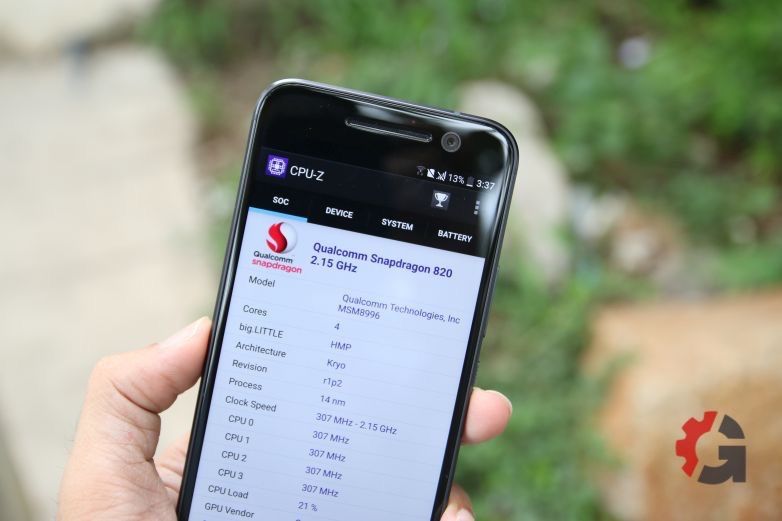
Oddly, the 10 became almost unusable when apps were installing/updating in the background. This behavior is common on even the most powerful devices, but the 10 stuttered considerably more than you would expect from a device with the latest hardware. Furthermore, despite the 4GB of RAM, the 10 sometimes removed apps from memory a bit too quickly. It’s unclear if this is done by the Boost+ app that comes preloaded on the phone, but multitasking isn’t as good as one would expect from a device with 4GB of RAM.
The phone doesn’t break a sweat no matter what you throw at it.
A few online reviews mention how the HTC 10 is the fastest Android flagship this year, but that is not exactly true when you take a close look. HTC has made the OS’ animations faster in an effort to give the feeling of quickness, but you can notice how its performance isn’t exactly as quick as the animations would suggest. For example, when opening a settings menu, you can see how the available options take an extra second to become usable after showing up on the screen. The same goes for the call screen when you make/receive a call. Games also take a few additional seconds to load compared to the Galaxy S7 (in this case, the S7’s quick UFS 2.0 storage might be the reason why it gets you into the game before HTC’s device).
The 10’s fingerprint sensor is right up there with the best – it’s quick and extremely accurate.
The 10’s fingerprint sensor is right up there with the best – it’s quick and extremely accurate. It’s faster than the Galaxy S7’s sensor purely because you don’t have to press a button in order to unlock the phone. It’s not as fast as the rear-facing fingerprint sensors on other phones, however, when it comes to waking up the screen and unlocking the device. This is normal as a rectangular button on the front doesn’t offer as much space for your finger as a circular/square button, but the 10 certainly has one of the best implementations of a front-facing fingerprint sensor.
HTC 10 Battery Life: Not very dependable
Unlike other companies, HTC has been consistent at increasing the battery size in each new flagship. The 10 features a 3,000mAh battery, which is around 150mAh bigger than the battery on last year’s One M9 (and variants like the One M9 Plus). But at the same time, HTC has also made the upgrade to a Quad HD display, and as a result the 10’s battery life isn’t very dependable.
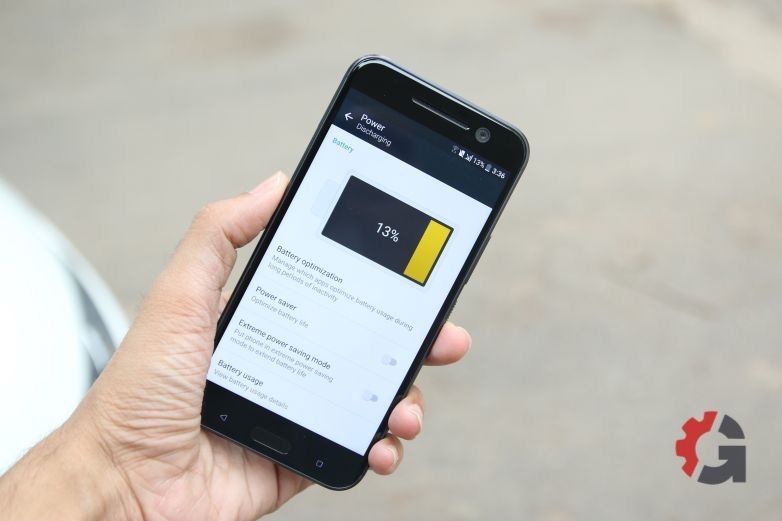 On Wi-Fi, getting 4 to 4.5 hours of screen time and making it through to the evening was fairly easy, but switching to mobile data had a huge effect on endurance. Idle battery drain was okay thanks to Marshmallow’s Doze feature, but active usage resulted in what you would call average battery life. Even activating the power saving mode didn’t seem to have any notable effect on endurance. HTC says you can achieve up to two days of battery life, but that claim is likely based on extremely frugal usage.
On Wi-Fi, getting 4 to 4.5 hours of screen time and making it through to the evening was fairly easy, but switching to mobile data had a huge effect on endurance. Idle battery drain was okay thanks to Marshmallow’s Doze feature, but active usage resulted in what you would call average battery life. Even activating the power saving mode didn’t seem to have any notable effect on endurance. HTC says you can achieve up to two days of battery life, but that claim is likely based on extremely frugal usage.
The HTC 10 adopts the new USB Type-C port for charging and wired device connectivity and comes with support for quick charging. You don’t need to use HTC’s own charger for fast charging – any fast charger will work. The only problem is that with the Type-C port being new on the market, you have to carry around the 10’s USB cable or risk being left without a means to charge the phone. This is true for any smartphone with a Type-C port, however, so anyone looking to pick up the HTC 10 would do well to buy an additional bunch of USB Type-C cables. Just make sure you pick up the right cable, as some Type-C cables can wreak havoc on the device’s charging circuitry.
HTC 10 Conclusion: So, should you buy the HTC 10?
I like the HTC 10. As a huge fan of the One M8, it’s great to see that HTC has finally managed to make a flagship that isn’t a letdown in any particular area. But, while the One M8 felt ahead of its time when it launched two years ago, the 10 has the misfortune of having to battle it out with competing devices that are either more feature-packed or offer a similar experience at extremely low price points.
I’m talking about the Samsung Galaxy S7 and the new OnePlus 3 in particular. The Galaxy S7 can’t match the beautiful design (visually, not in terms of build quality) or the audio quality of the 10, but it makes up for those with a better camera, punchier and brighter display, waterproofing, and support for Samsung’s virtual reality headset, the Gear VR. The OnePlus 3, meanwhile, offers an experience nearly as good as the 10’s, at a price that’s almost exactly half of what the 10 currently costs.
Also read: OnePlus 3 Review: Finally, the flagship killer we all deserve
But does that mean that you shouldn’t buy the phone? Not at all. The HTC 10, apart from its average battery life, will give you a great smartphone experience. It’s a no-frills device that oozes quality and class, and the only thing that stops me from really recommending it is its Rs 52,000 price tag. But if you have the money to spare, well, go crazy and go get yourself the HTC 10!
























